Related Research Articles

Mannerism is a style in European art that emerged in the later years of the Italian High Renaissance around 1520, spreading by about 1530 and lasting until about the end of the 16th century in Italy, when the Baroque style largely replaced it. Northern Mannerism continued into the early 17th century.

The Uffizi Gallery is a prominent art museum located adjacent to the Piazza della Signoria in the Historic Centre of Florence in the region of Tuscany, Italy. One of the most important Italian museums and the most visited, it is also one of the largest and best-known in the world and holds a collection of priceless works, particularly from the period of the Italian Renaissance.
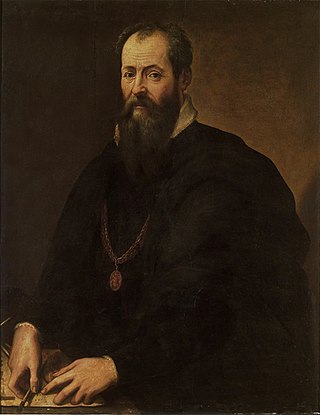
Giorgio Vasari was an Italian Renaissance painter and architect, who is best known for his work Lives of the Most Excellent Painters, Sculptors, and Architects, considered the ideological foundation of all art-historical writing, and still much cited in modern biographies of the many Italian Renaissance artists he covers, including Leonardo da Vinci and Michelangelo, although he is now regarded as including many factual errors, especially when covering artists from before he was born.

Chiaroscuro, in art, is the use of strong contrasts between light and dark, usually bold contrasts affecting a whole composition. It is also a technical term used by artists and art historians for the use of contrasts of light to achieve a sense of volume in modelling three-dimensional objects and figures. Similar effects in cinema, and black and white and low-key photography, are also called chiaroscuro.

Sfumato is a painting technique for softening the transition between colours, mimicking an area beyond what the human eye is focusing on, or the out-of-focus plane. It is one of the canonical painting modes of the Renaissance. Leonardo da Vinci was the most prominent practitioner of sfumato, based on his research in optics and human vision, and his experimentation with the camera obscura. He introduced it and implemented it in many of his works, including the Virgin of the Rocks and in his famous painting of the Mona Lisa. He described sfumato as "without lines or borders, in the manner of smoke".

Annibale Carracci was an Italian painter and instructor, active in Bologna and later in Rome. Along with his brother and cousin, Annibale was one of the progenitors, if not founders of a leading strand of the Baroque style, borrowing from styles from both north and south of their native city, and aspiring for a return to classical monumentality, but adding a more vital dynamism. Painters working under Annibale at the gallery of the Palazzo Farnese would be highly influential in Roman painting for decades.
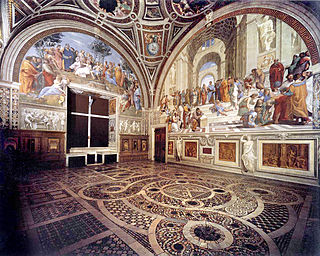
In art history, the High Renaissance was a short period of the most exceptional artistic production in the Italian states, particularly Rome, capital of the Papal States, and in Florence, during the Italian Renaissance. Most art historians state that the High Renaissance started between 1490 and 1500, and ended in 1520 with the death of Raphael, although some say the High Renaissance ended about 1525, or in 1527 with the Sack of Rome by the army of Charles V, Holy Roman Emperor, or about 1530. The best-known exponents of painting, sculpture and architecture of the High Renaissance include Leonardo da Vinci, Michelangelo, Raphael, and Bramante. In the 21st century, the use of the term has been frequently criticized by some academic art historians for oversimplifying artistic developments, ignoring historical context, and focusing only on a few iconic works.

The Sleeping Cupid is a now-lost sculpture created by Renaissance artist Michelangelo, which he artificially aged to make it look like an antique on the advice of Lorenzo di Pierfrancesco in order to sell for a higher price. It was this sculpture which first brought him to the attention of patrons in Rome.

Caravaggio created one of his most admired altarpieces, The Entombment of Christ, in 1603–1604 for the second chapel on the right in Santa Maria in Vallicella, a church built for the Oratory of Saint Philip Neri. A copy of the painting is now in the chapel, and the original is in the Vatican Pinacoteca. The painting has been copied by artists as diverse as Rubens, Fragonard, Géricault and Cézanne.

The Self-Portrait with a Friend is a painting by Italian High Renaissance painter Raphael. It dates to 1518–1520, and is in the Louvre Museum of Paris, France. Whether the figure on the left is actually a self-portrait by Raphael is uncertain, although it was already identified as such in a 16th-century print.
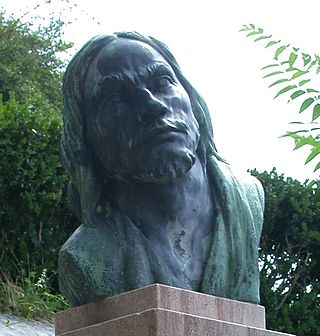
Pordenone, Il Pordenone in Italian, is the byname of Giovanni Antonio de’ Sacchis, an Italian Mannerist painter, loosely of the Venetian school. Vasari, his main biographer, wrongly identifies him as Giovanni Antonio Licinio. He painted in several cities in northern Italy "with speed, vigor, and deliberate coarseness of expression and execution—intended to shock".
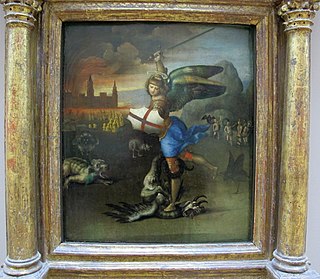
St. Michael Vanquishing Satan is a painting by the Italian High Renaissance artist Raphael. The image consists of the archangel Michael standing on top of Satan's back with his right foot. Both works have been located in the Louvre in Paris since 1667. The painting was commissioned by Pope Leo X.

The Parnassus is a fresco painting by the Italian High Renaissance artist Raphael in the Raphael Rooms, in the Palace of the Vatican in Rome, painted at the commission of Pope Julius II.
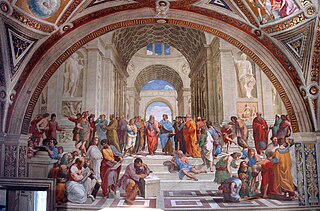
Pope Julius II, commissioned a series of highly influential art and architecture projects in the Vatican. The painting of the Sistine Chapel ceiling by Michelangelo and of various rooms by Raphael in the Apostolic Palace are considered among the masterworks that mark the High Renaissance in Rome. His decision to rebuild St Peter's led to the construction of the present basilica.

Florentine painting or the Florentine School refers to artists in, from, or influenced by the naturalistic style developed in Florence in the 14th century, largely through the efforts of Giotto di Bondone, and in the 15th century the leading school of Western painting. Some of the best known painters of the earlier Florentine School are Fra Angelico, Botticelli, Filippo Lippi, the Ghirlandaio family, Masolino, and Masaccio.

Italian Renaissance painting is the painting of the period beginning in the late 13th century and flourishing from the early 15th to late 16th centuries, occurring in the Italian Peninsula, which was at that time divided into many political states, some independent but others controlled by external powers. The painters of Renaissance Italy, although often attached to particular courts and with loyalties to particular towns, nonetheless wandered the length and breadth of Italy, often occupying a diplomatic status and disseminating artistic and philosophical ideas.
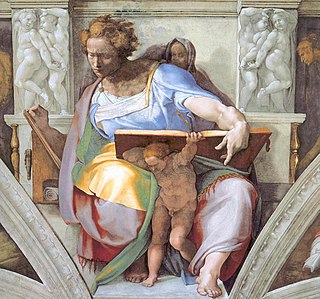
According to the theory of the art historian Marcia B. Hall, which has gained considerable acceptance, cangiante is one of the canonical painting modes of the Renaissance; i.e. one of the four modes of painting colours available to Italian High Renaissance painters, along with sfumato, chiaroscuro and unione. The word itself is the present participle of the Italian verb cangiare.
Il Paradiso is a massive oil painting on canvas that dominates the main hall of the Doge's Palace, which hosted the Great Council of Venice. It is one of the largest paintings on canvas in the world and was painted by Jacopo Robusti, known more commonly as Tintoretto, son of a Venetian dyer. The painting features a heavenly scene with depictions of various religious figures such as the portrayal of Justina, patron saint of Padua.
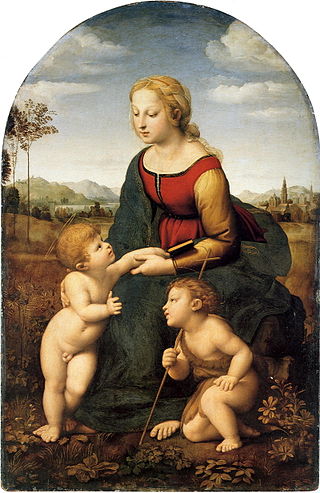
According to the theory of the art historian Marcia B. Hall, which has gained considerable acceptance, unione is one of the canonical painting modes of the Renaissance; that is, one of four modes of painting colours available to Italian High Renaissance painters, along with sfumato, chiaroscuro and cangiante. Unione was developed by Raphael, who exemplified it in the Stanza della Segnatura.
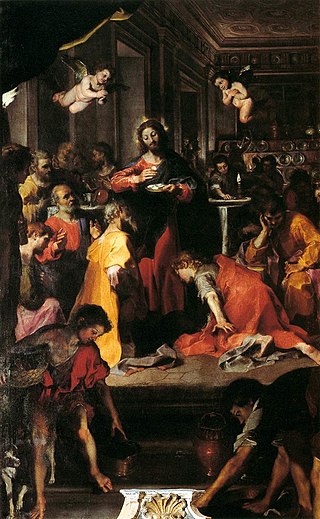
The Communion of the Apostles, or Institution of the Eucharist is a painting of the Last Supper by Federico Barocci located at Santa Maria sopra Minerva in Rome. It was commissioned for the family chapel of Pope Clement VIII Aldobrandini and completed between 1603 and 1608.
References
- 1 2 3 4 "Marcia Hall, PhD". Tyler School of Art. Temple University. 27 March 2013. Retrieved 11 August 2021.
- 1 2 3 4 Sorensen, Lee, ed. "Hall, Marcia B.", Dictionary of Art Historians. 11 August 2021.
- ↑ Hall, Marcia B. (1974). "The Tramezzo in Santa Croce, Florence, Reconstructed". The Art Bulletin. 56 (3): 325–341. doi:10.2307/3049260. ISSN 0004-3079. JSTOR 3049260.
- ↑ Hall, Marcia B. (1974). "The Ponte in S. Maria Novella: The Problem of the Rood Screen in Italy". Journal of the Warburg and Courtauld Institutes. 37: 157–173. doi:10.2307/750838. ISSN 0075-4390. JSTOR 750838. S2CID 195009392.
- ↑ "Nonfiction Book Review: Color and Meaning: Practice and Theory in Renaissance Painting by Marcia B. Hall, Author Cambridge University Press $70 (288p) ISBN 978-0-521-39222-8". PublishersWeekly.com. Retrieved 11 August 2021.
- ↑ Hills, Paul (1995). "Marcia B. Hall. Color and Meaning: Practice and Theory in Renaissance Painting. Cambridge and New York: Cambridge University Press, 1992. 48 col. pls. + 83 b&w pls. + xiii + 273 pp. $60". Renaissance Quarterly. 48 (1): 190–192. doi:10.2307/2863351. ISSN 0034-4338. JSTOR 2863351. S2CID 163190316.
- ↑ Gill, Meredith J. (1992). "Review of Color and Meaning: Practice and Theory in Renaissance Painting". Renaissance and Reformation / Renaissance et Réforme. 16 (4): 83–85. ISSN 0034-429X. JSTOR 43444866.
- ↑ Stahl, Louise Z. (1993). "Color and meaning: Practice and theory in renaissance painting, by Marcia Hall, Cambridge University Press, Cambridge, New York, 1991, 288 pp., $60". Color Research & Application. 18 (4): 288. doi:10.1002/col.5080180412. ISSN 1520-6378.
- ↑ "Nonfiction Book Review: Michelangelo: The Frescoes of Sistine Chapel by Marcia B. Hall, Author, Takashi Okamura, Photographer ABRAMS $39.95 (240p) ISBN 978-0-8109-3530-3". PublishersWeekly.com. Retrieved 11 August 2021.
- ↑ The Cambridge Companion to Raphael via scholar.google.com. Retrieved 2022-12-27.
- ↑ Bailey, Gauvin Alexander (2012). "Marcia B. Hall. The Sacred Image in the Age of Art: Titian, Tintoretto, Barocci, El Greco, Caravaggio. New Haven: Yale University Press, 2011. x + 310 pp. $75. ISBN: 978–0–300–16967–6". Renaissance Quarterly. 65 (3): 885–886. doi:10.1086/668316. ISSN 0034-4338.
- ↑ Arnold, Jeremy W. H. (2012). "The Sacred Image in the Age of Art: Titian, Tintoretto, Barocci, El Greco, Caravaggio – By Marcia B. Hall". Religious Studies Review. 38 (1): 14. doi:10.1111/j.1748-0922.2011.01576_1.x. ISSN 1748-0922.
- ↑ Mansfield, Elizabeth C. (2021). "The Power of Color: Five Centuries of European Painting by Marcia B. Hall (review)". Eighteenth-Century Studies. 54 (2): 486–489. doi:10.1353/ecs.2021.0020. ISSN 1086-315X. S2CID 234200058.